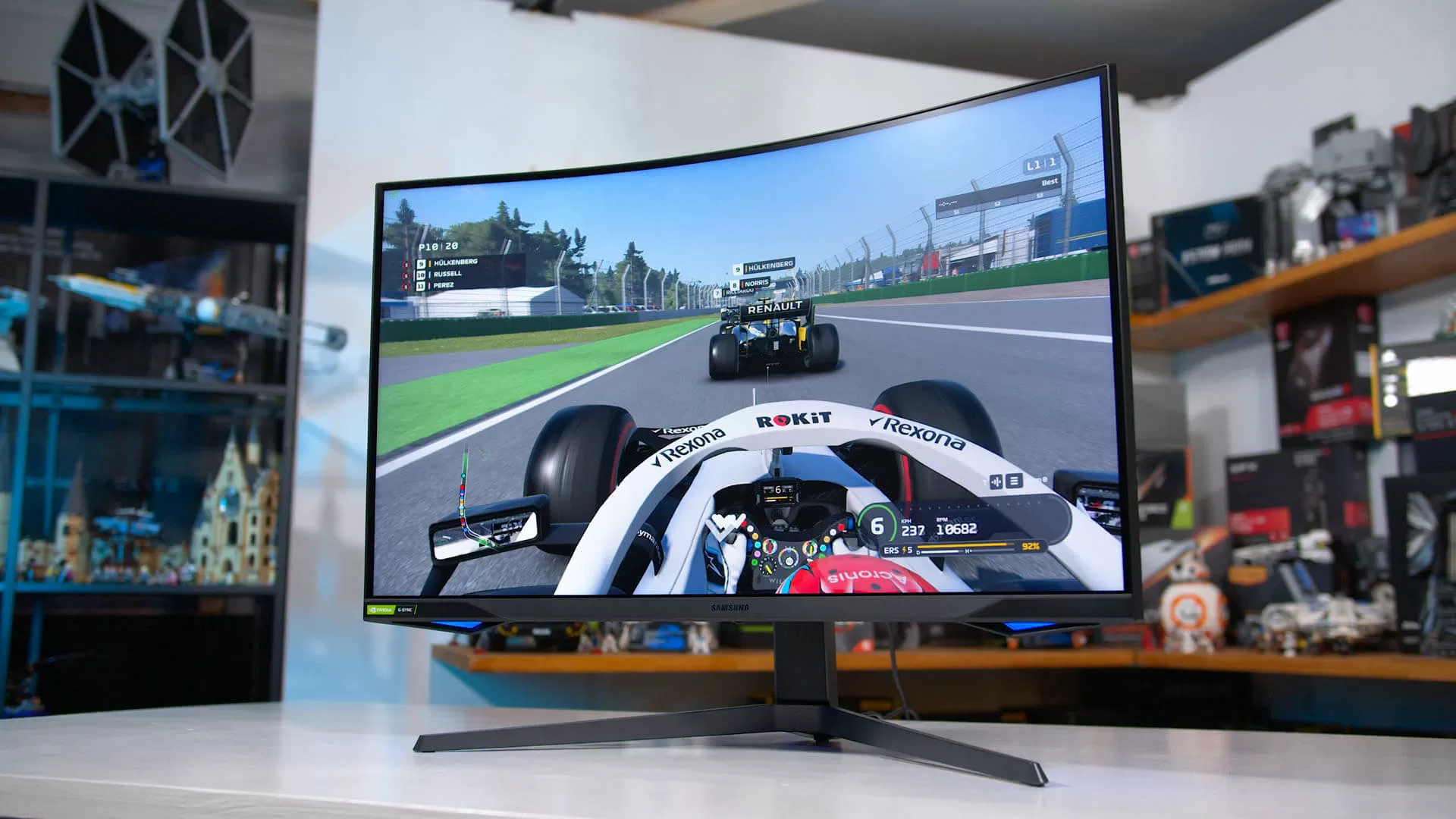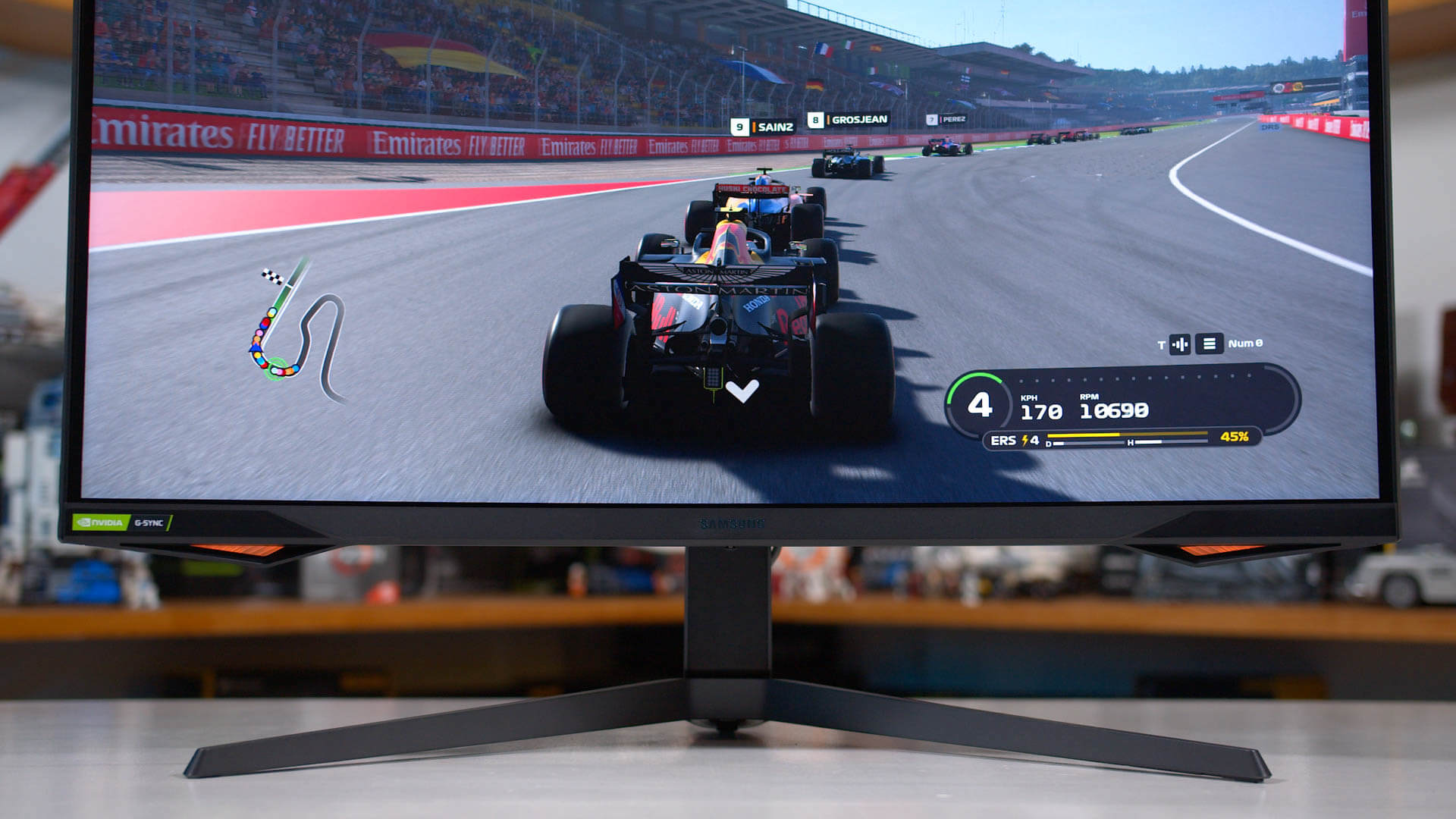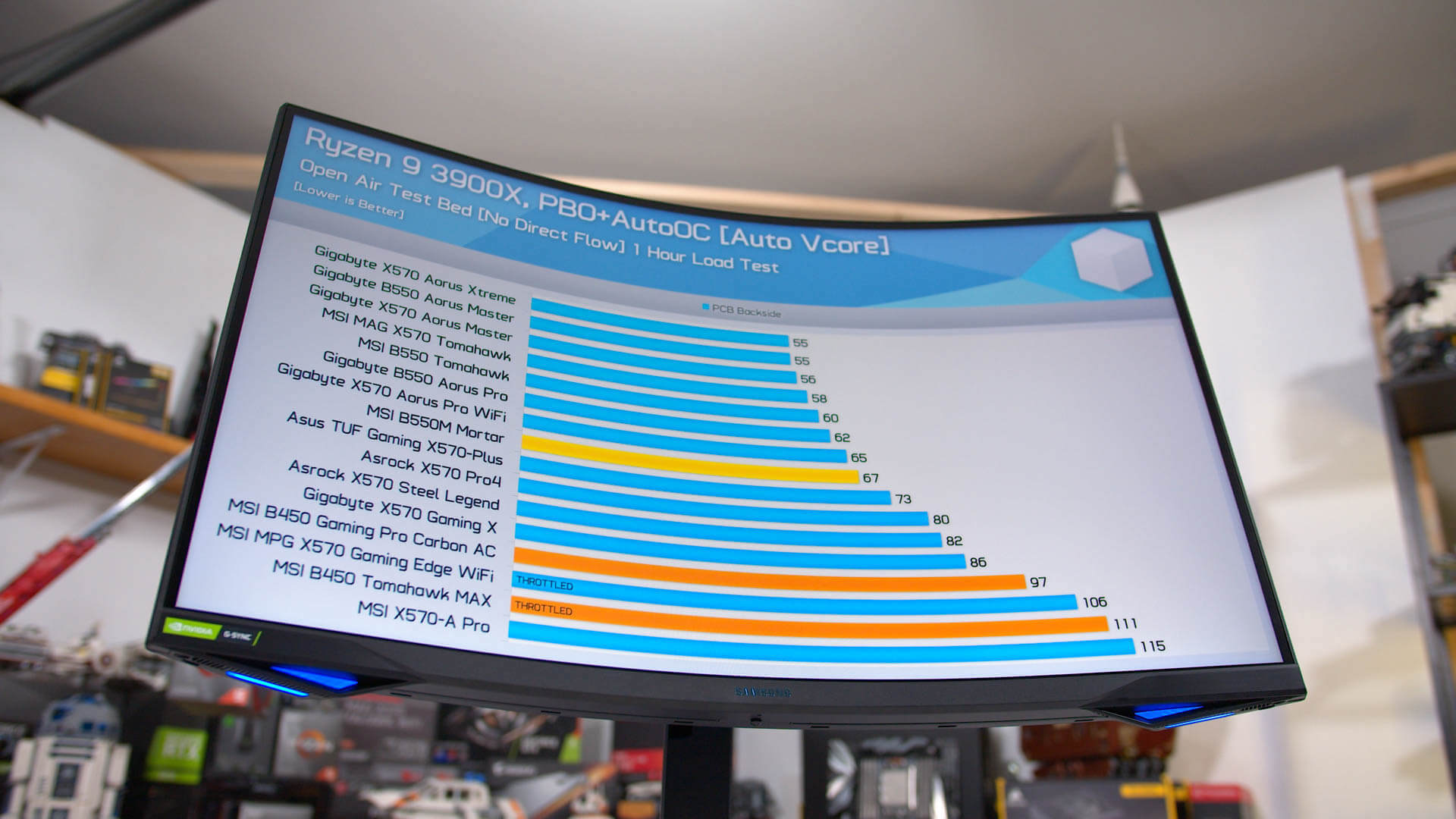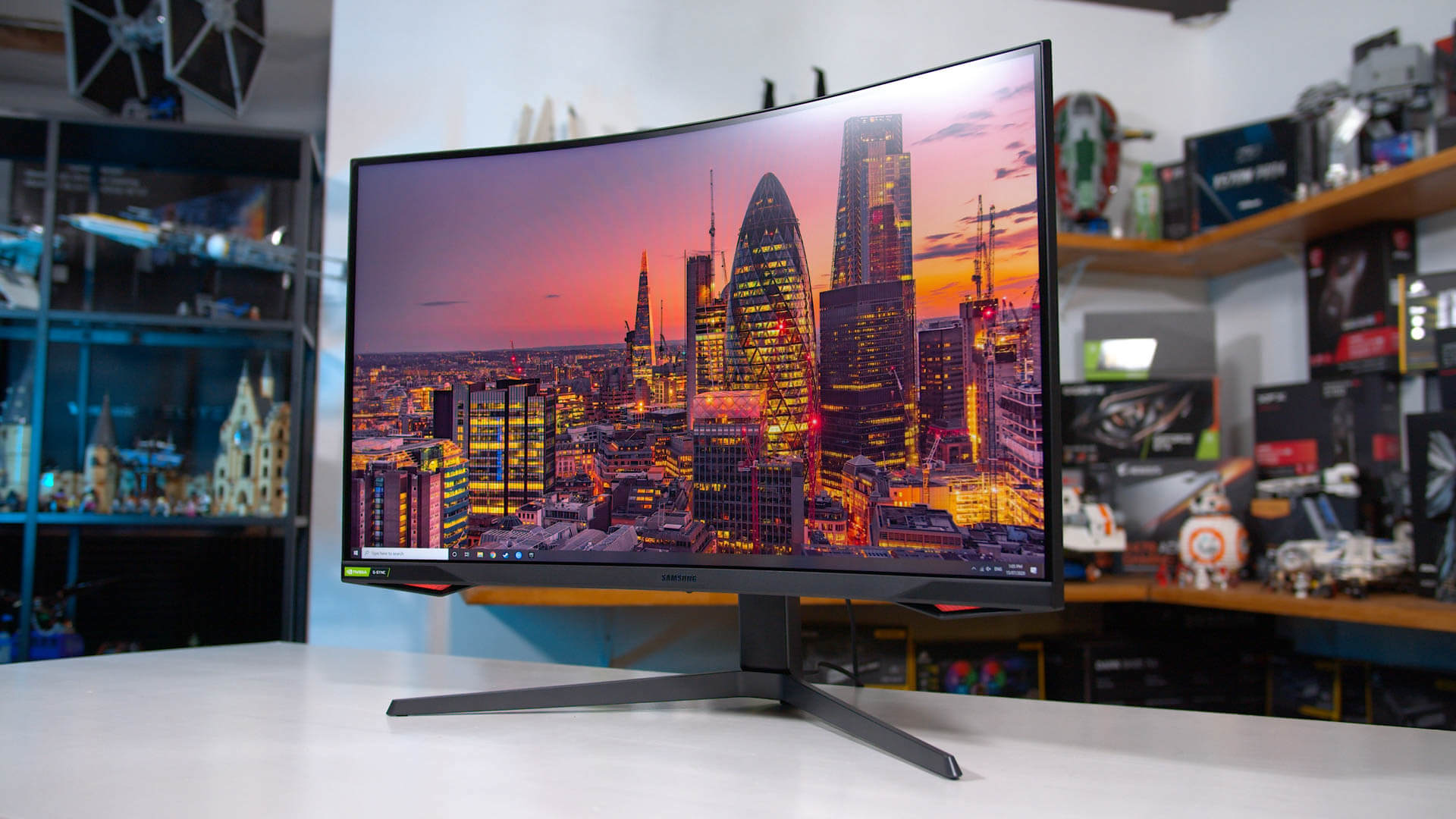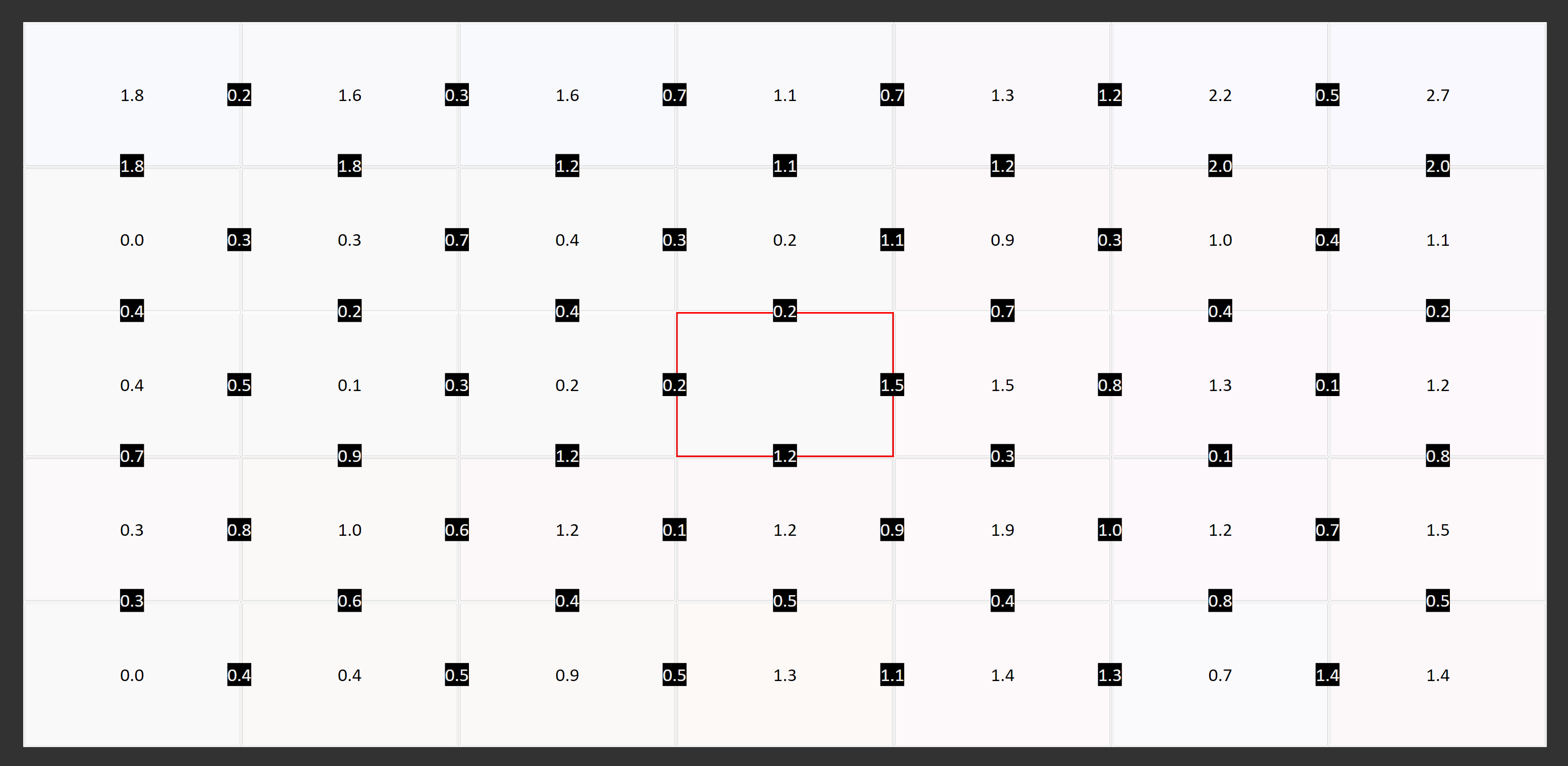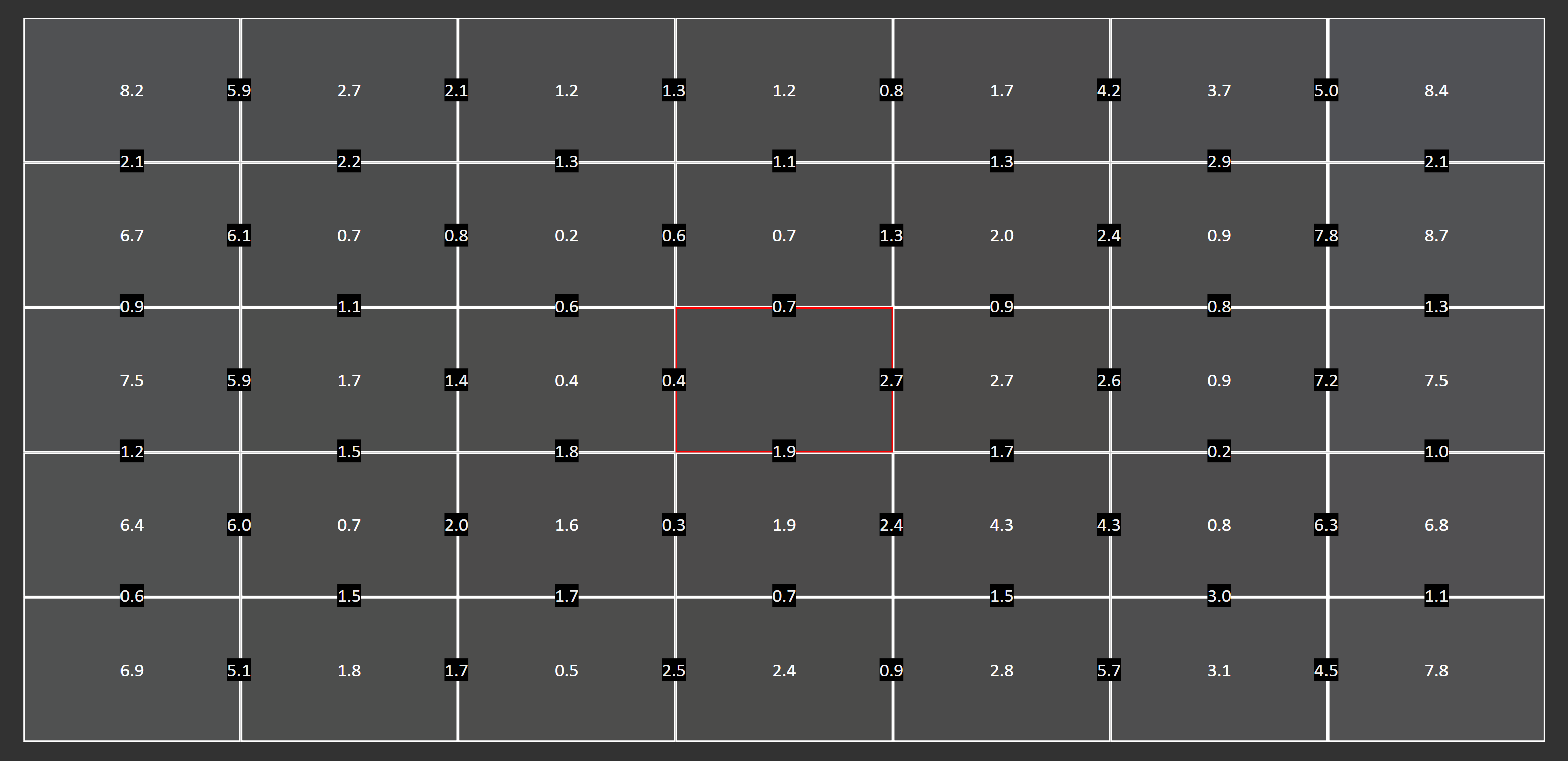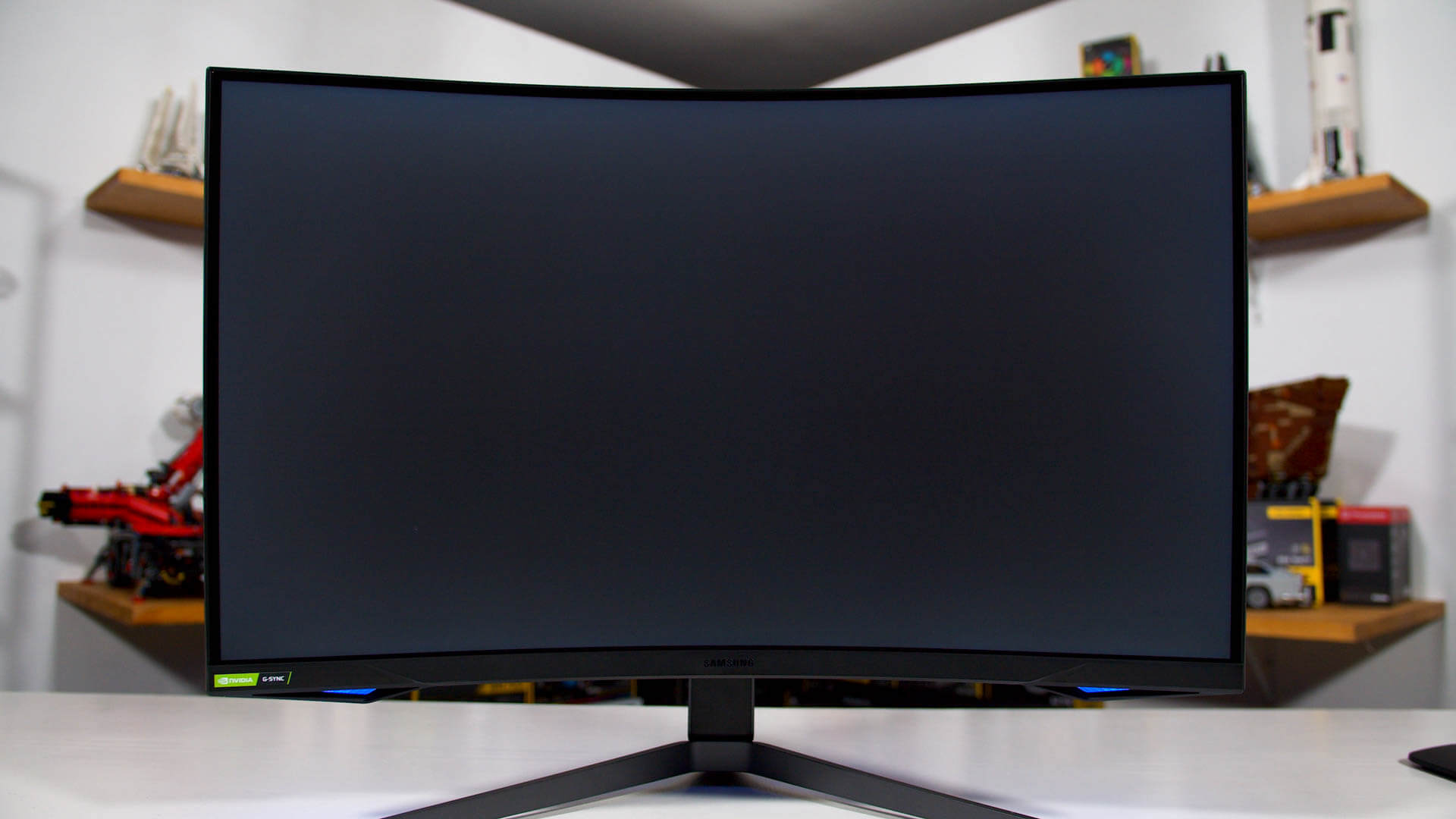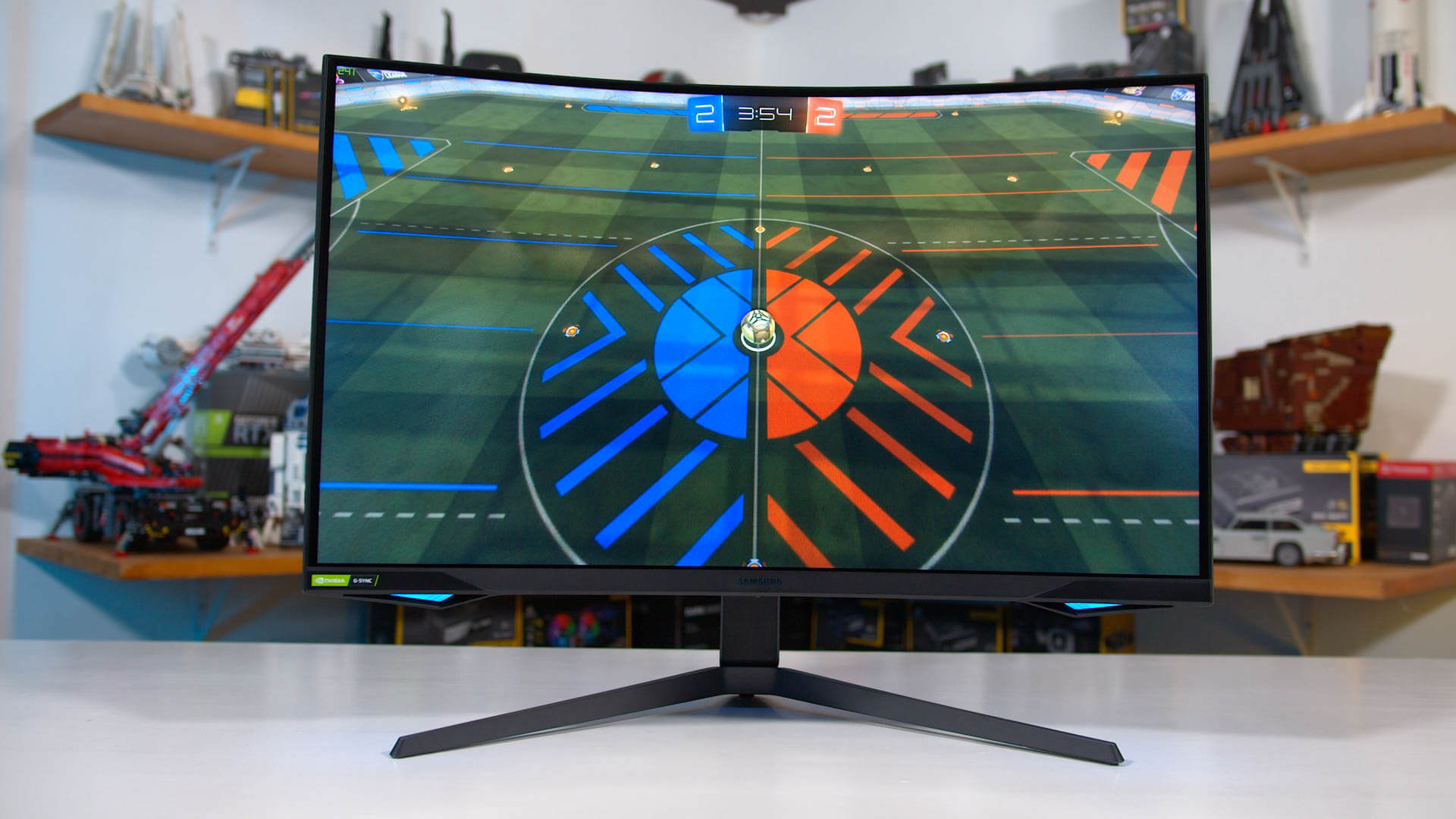This is one of the most heavily requested monitor reviews we've had in quite some time. Samsung has done well in creating hype around the Odyssey G7, and today the embargo has lifted for us to publish this review even though the monitor has been on sale in some countries and we've had one in our labs for a few weeks now.
First, the spec sheet: the Samsung Odyssey G7 sports a 2560 x 1440 resolution, 240Hz refresh rate, VA panel, 1000R curvature and even some DisplayHDR 600 functionality. No doubt part of the anticipation comes from this next generation Samsung VA panel that can handle a 240Hz refresh rate.
We've tested the 32-inch variant of the Odyssey G7 which sells for $800, slotting in the high end of the 1400p gaming segment. A smaller 27-inch model is available for $700 and there's also the $1,700 Odyssey G9, which is a massive ultrawide which we hope to review later on.
Design
Samsung has done a good job on the design front. The build quality is excellent, befitting of a high-end flagship product. While most of the outer surface is plastic, including the wide-pronged stand, it's a nice high quality plastic with a solid matte finish.
The rear of the monitor features this unique pattern that draws attention to the center circle where the display is mounted to the stand. Here's where you find Samsung's "Infinity Core" lighting, which is just a fancy name for RGB LEDs that illuminate this area. There are also two small lighting zones on the front – single RGB zones here, too – honestly we could give or take the RGB elements, but at least they're integrated well into the design.
The stand is moderately sturdy and has a good range of motion, including height, tilt, pivot and swivel adjustment. The level of height adjustment is quite decent for a large 32-inch panel, and you can use this monitor in a portrait orientation, too, if you want to use a curved monitor like that. It does support VESA mounting as well.
The big elephant in the room is that curve: 1000R. This is almost, but not quite, twice as curved as the more standard 1800R curve that's used by most other curved monitors. Even compared to some newer 1500R options, the 1000R curve is much more noticeable and obvious.
So the question is, do I like the curve? Is 1000R the way forward for monitors? And the answer in my opinion is a resounding no. In fact, I hate this monitor's curve, I'm not a fan of an 1800R curve with a 16:9 aspect ratio display at the best of times, but 1000R is just ridiculous. Can't say who asked for this and ultimately we think will turn off more buyers than it will attract.
We do have some specific reasons why we don't like this, coming after nearly a month of using the Odyssey G7. First is distortion, especially when viewing the 32-inch panel at a normal viewing distance. If you move a flat image across the display, it will noticeably warp as it passes from one side, through the center, to the other side. It's basically the exact opposite of lens distortion you might have seen with a fisheye or wide angle lens. It looks wrong. While my brain can usually compensate for that distortion on an 1800R panel, it's too overwhelming at 1000R, especially with desktop or productivity apps. This hurts the versatility of this monitor, so we don't think it's a good dual-use monitor for gaming and creative work, for example.
We will say, however, that the obviousness of this distortion will depend on how close you sit to the display. Normally, I sit ~60 to 80 cm away from my monitor (24 - 32 in). But if I viewed the Odyssey G7 from up closer, the curve was far less noticeable and the experience was more immersive. Then again, I feel sitting as close as 40 cm (15 in) away from a monitor is too close and would probably cause severe eye strain after prolonged use. We also thought the curve is something we might get used to, but after nearly a month we just haven't.
For ports, the Odyssey G7 includes two DisplayPort connectors and HDMI 2.0. We feel the lack of HDMI 2.1 is a bit of a miss. There's also a 2-port USB hub and an audio output jack.
The OSD is controllable through a directional toggle along the bottom edge of the screen, very easy to navigate though it's not the most feature-rich OSD experience. There are a selection of color controls and picture in picture modes, as well as a shadow boosting and cheat crosshair modes, but you're not getting as much functionality as the latest high-end monitors from Asus or Gigabyte.
Display Performance
Response Times / Overdrive Modes
Another of the key questions going into this review was: can Samsung's latest VA panels actually deliver response times that are good enough for 240Hz gaming? Well, let's find out, but there is an interesting note here first: you can't change the overdrive setting with adaptive sync enabled. So whether you use this with FreeSync on an AMD GPU, or G-Sync with an Nvidia GPU, overdrive controls are greyed out. This makes testing much more straightforward, but can be prone to issues if that one overdrive option isn't amazing.
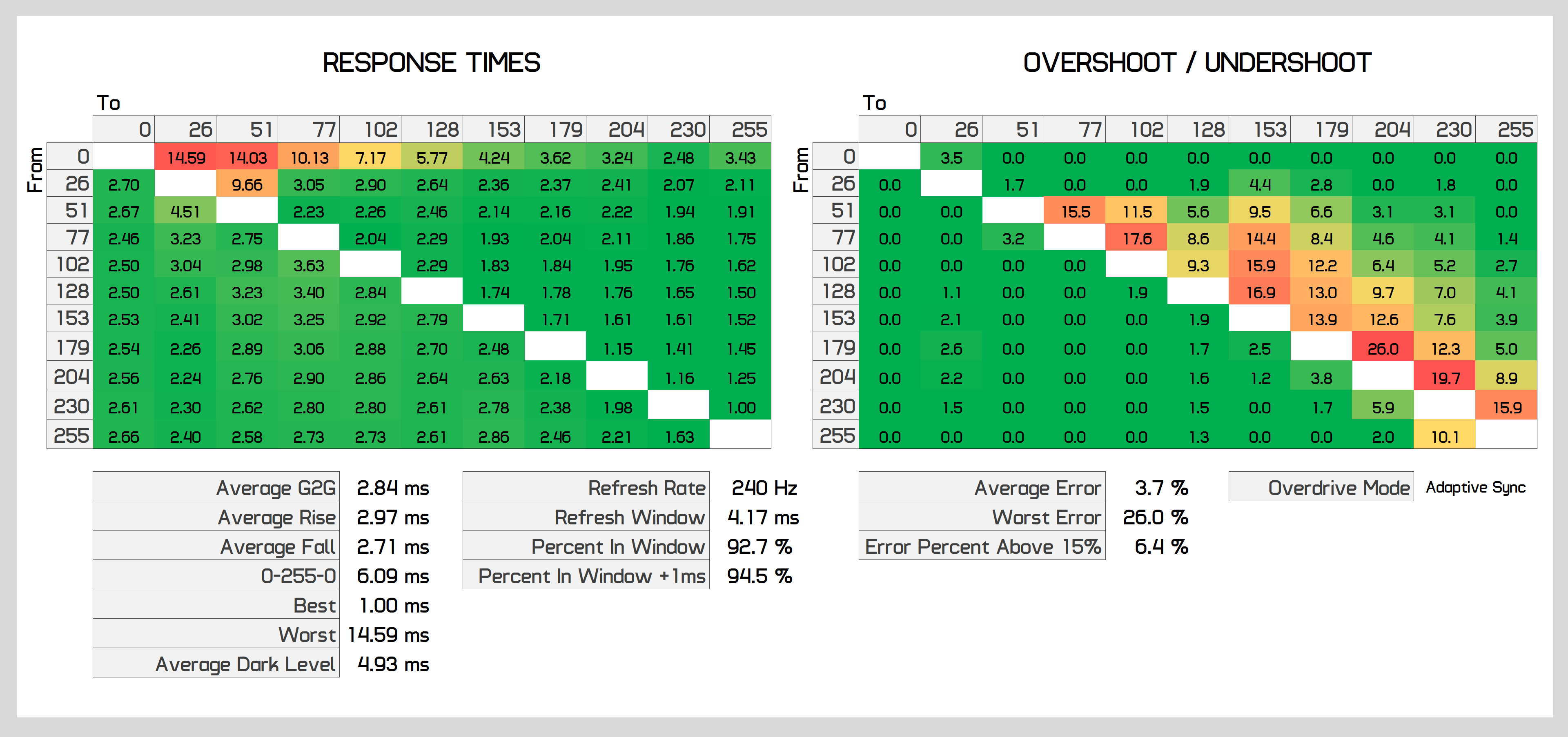
Luckily, at 240Hz the Odyssey G7 delivers astonishingly good response times. Not just good for VA response times, but good for any monitor we've tested, including TN panels. What we're seeing here is quite remarkable for a monitor technology that has often been criticized for being slow and not suitable for gaming. You can throw that idea right out the window with the G7: Samsung's next-gen VA tech can compete with the big boys.
At 240Hz we see an average grey to grey response time of 2.84ms, which means that more than 90% of transitions are truly fast enough for a 240Hz experience. We also see minimal overshoot. Yes, there's a bit creeping in for some sub-2ms transitions, but on the whole you get limited inverse ghosting that we found hard to notice.
What's also impressive is the amount of dark level smearing. VAs typically have very slow transitions in the region up to around 102 or 128 grey, particularly when transitioning from full black. But that's not the case here. We should also say that this performance was captured after the monitor had warmed up for several hours to a nice steady state, VAs can be much slower when they are first turned on and running "cold," so you might notice a bit more trailing and ghosting in the first 30 to 60 minutes of use. But once it's reached steady state, there's practically zero ghosting with this monitor at 240Hz, even for a lot of darker content.
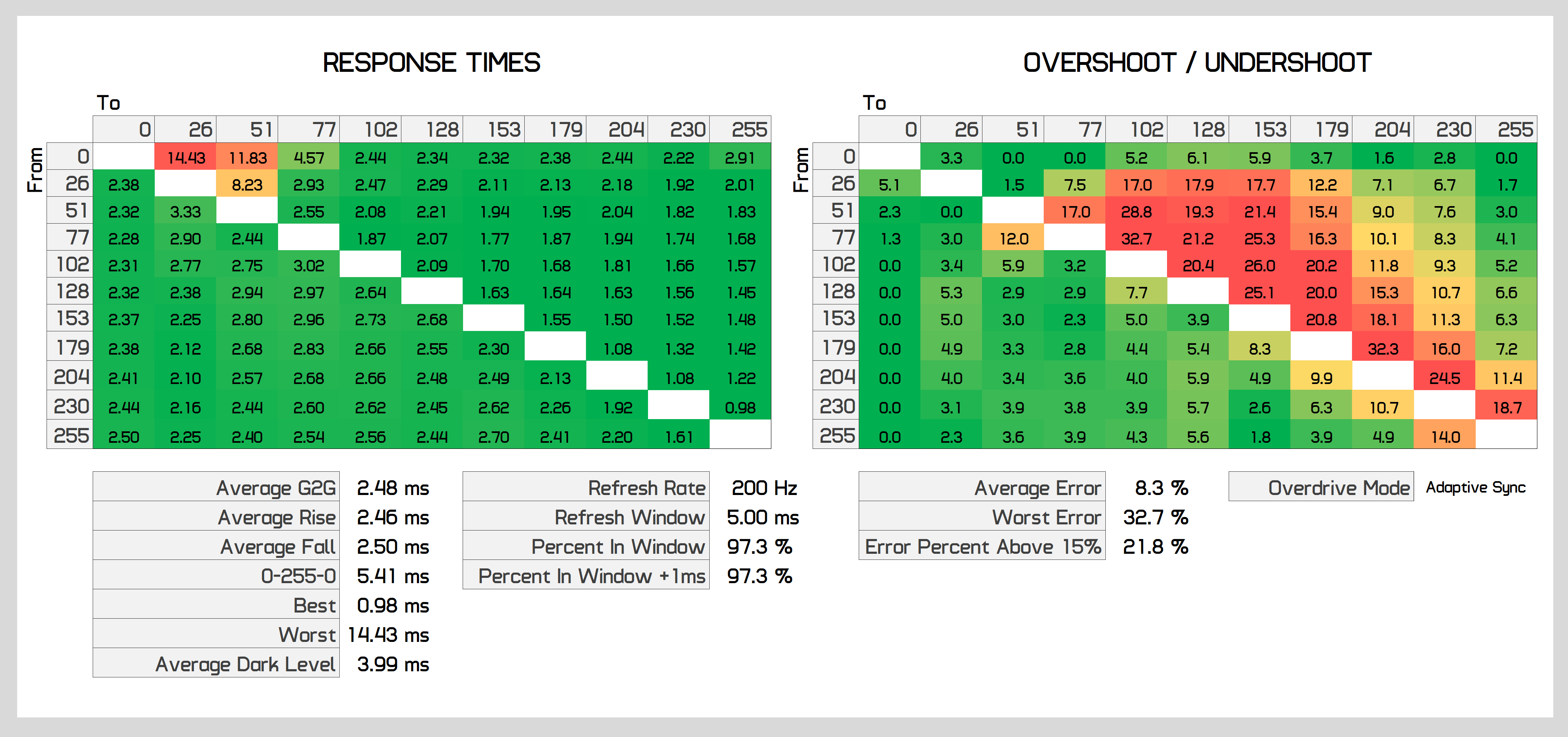
What's even better about the Odyssey G7, this sort of performance is largely held throughout the refresh range. When dipping to 200Hz we saw the most overshoot of any refresh rate tested, but given the 2.5ms response time this isn't too bad and in practice you don't see much inverse ghosting.

At 165Hz, dark level smearing is almost entirely eliminated from the G7 while maintaining a 3ms response time with no overshoot. This continues through 144Hz and 120Hz. By the time we're down at 100Hz, there is a bit more overshoot present in the dark level area, but again, the Odyssey G7 maintains around that 3ms response. Then at 85Hz and 60Hz, we fall to a 4ms response with a small amount of dark level smearing.

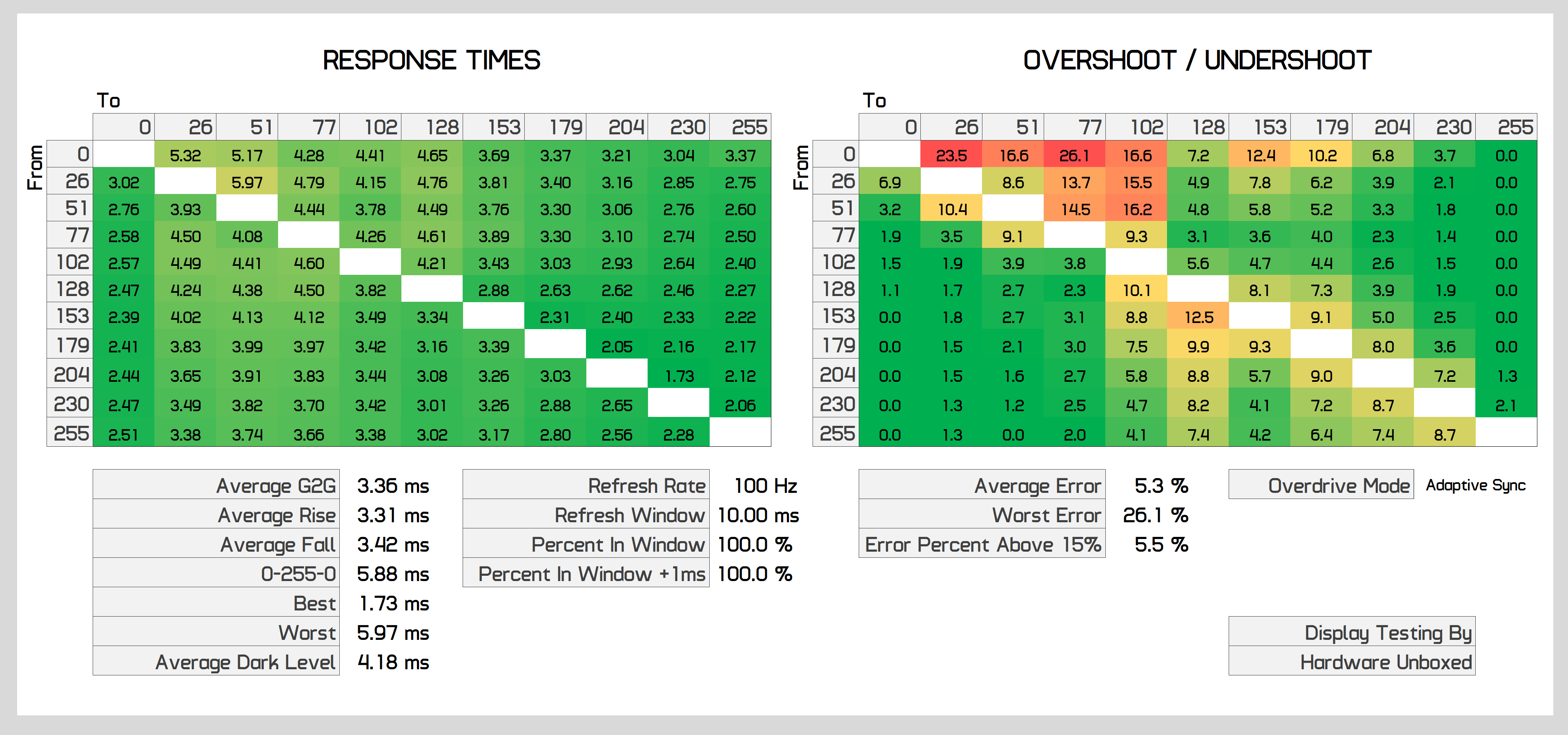
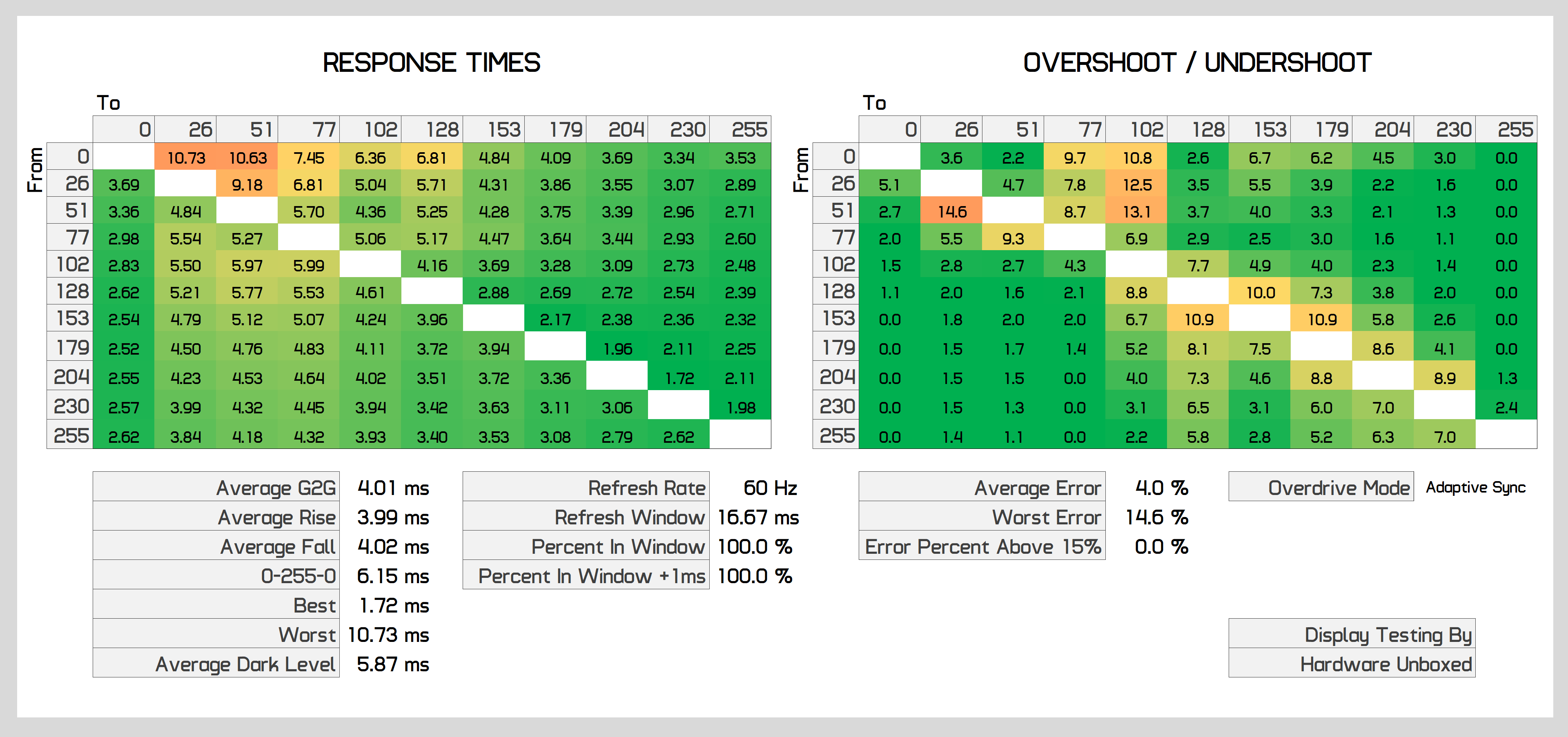
The important thing to note is that at no point does this monitor require a different overdrive setting. You can't change the overdrive mode with adaptive sync enabled anyway, but there's no reason to. Samsung has tuned this display to perfection, delivering performance right on the edge of what the VA panel is capable of at all refresh rates tested. We're not sure whether they are using variable overdrive - they aren't using a G-Sync module - but Samsung clearly know their own panel technology well and have paid special attention to dark level performance.
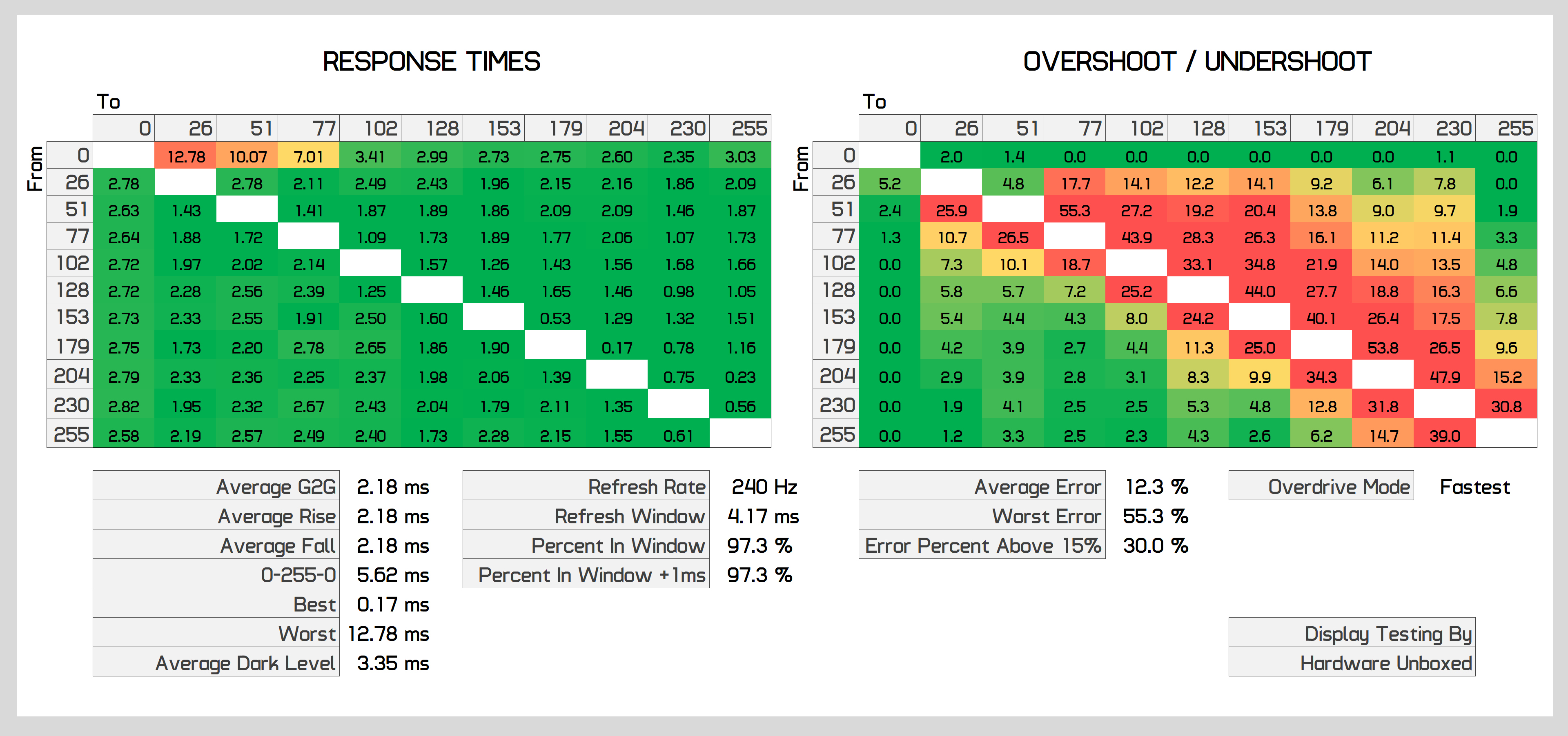
You can push the response times higher if you disable adaptive sync and switch to the "fastest" overdrive setting, however this introduces noticeable inverse ghosting. Both the "standard" and "faster" modes appear identical and perform exactly like the adaptive sync on results we've just been showing.

Compared to other monitors, the Odyssey G7 delivers elite performance. At 240Hz, this monitor delivers an average experience equivalent to the best TN displays on the market, such as the HP Omen X 27 and the Gigabyte Aorus KD25F. It also outperforms the best we've seen from IPS so far, including the "1ms" class tech used in the LG 27GL850 and LG 27GN750.
We should note that the first 1440p 240Hz IPS panels are set to hit the market later this year, which is going to be a very interesting battle up against the G7's VA.
We're also seeing performance that far outstrippes the best VA monitors we had tested before. Something like the Viotek GFV27DAB which all things considered has well tuned overdrive and uses a previous-gen Samsung VA panel, is nearly twice as slow. Then when you look at other options like the LG 32GK650F or AOC CQ27G2, it's a no contest, those VAs aren't remotely in the same class.

Dark level performance is good, but we do see results that are more mid-table, around the mark of a typical IPS display. TNs can hold the performance crown still, so if you want zero dark level smearing of any kind, your best bet remains a 1440p 240Hz display like the Omen X 27.

Looking at refresh rate compliance, we thought there was a high chance the Odyssey G7 wouldn't be fast enough for a true 240Hz experience, but were totally wrong on that front. Over 90% compliance is excellent and what you're left with is a low motion blur, low smearing 240Hz panel.
Average error rates are mid table, indicating Samsung are pushing the G7 to its limits without going overboard, this can be a tricky fine line to balance and Samsung appear to have navigated this challenge with precision.

At 60Hz, the Odyssey G7 is still impressive with its 4ms average response time, but not quite as fast as the HP Omen X 27 which maintains a 3ms response time throughout the entire refresh range with no dark level smearing.

Input latency is a non issue with this display, producing results that are in line with the Omen X 27 and faster than some other 240Hz+ displays we've tested. This is a highly responsive monitor in all regards, which is perfect for competitive gaming.
You might be thinking, surely with such fast response times, having a functional backlight strobing mode is an absolute no brainer, this should be the perfect display for reducing motion blur in that way! Unfortunately, we're let down here by Samsung's implementation, which doesn't perfectly time the strobe with the refresh, and there's no way to tweak said timing.
The end result is that only about 30% of the display had acceptable blur reduction, and this was in the lower third of the monitor. It's not unusual for the backlight strobe to be more effective in some areas than others, but the center of our unit as well as the entire upper half had noticeable double images at 240Hz. Overall this looked worse than having MBR disabled given the strong response times at 240Hz, and of course without being able to use adaptive sync and MBR at the same time, actually running games at the required 240Hz for this mode might be a challenge.

Meanwhile, at lower refresh rates like 144Hz or 120Hz, the entire screen was plagued with double images and there was significant inverse ghosting to boot given the MBR mode also cranks up the overdrive setting to "fastest". So we wouldn't recommend this mode at lower refreshes.

The one area where the Odyssey G7 is noticeably worse than the competition is power consumption. To achieve this level of performance, the G7 sucks down over 50W of power, which is ~70% higher than a typical 32-inch 1440p display at the same brightness level. This is without the monitor's RGB lighting enabled, too.
Color Performance
Color Space: Samsung Odyssey G7 32" - D65-P3
Now we know response time performance is best-in-class from the Odyssey G7, but how does it fare for color reproduction? This is a wide gamut monitor, in our testing covering 89% of the P3 gamut. This is around the same coverage as many other wide gamut VAs, so there's been no progress on this front. IPS monitors like the LG 27GL850 still get much closer to full P3 reproduction with 95 to 96% coverage in our testing.
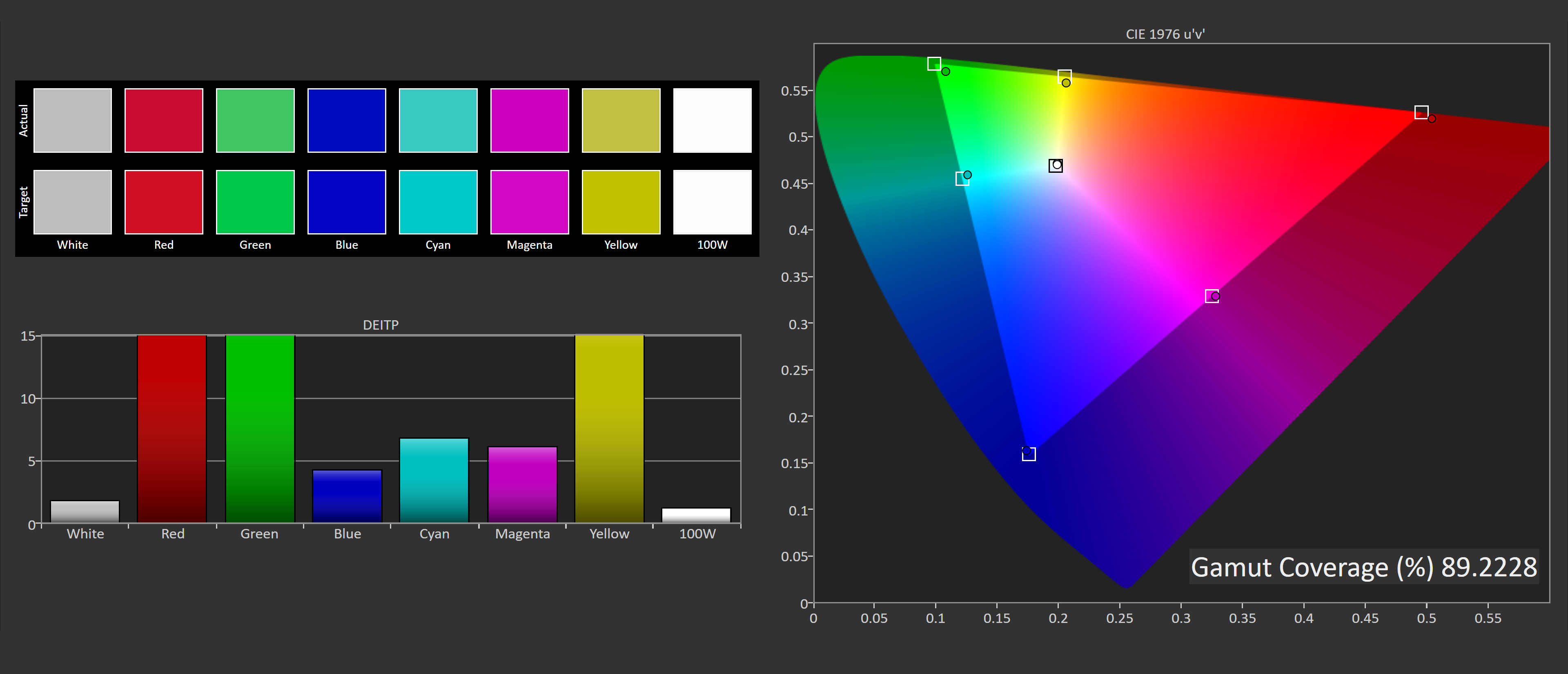
Default Color Performance

Samsung are factory calibrating each Odyssey G7, and you can view the calibration results in the monitor itself. While Samsung does have a large deltaE tolerance of 5.0 for calibration - this should be 3.0 or ideally 2.0 - my monitor did pass with a sub 2.0 deltaE, according to Samsung. But how did it fare in my tests?
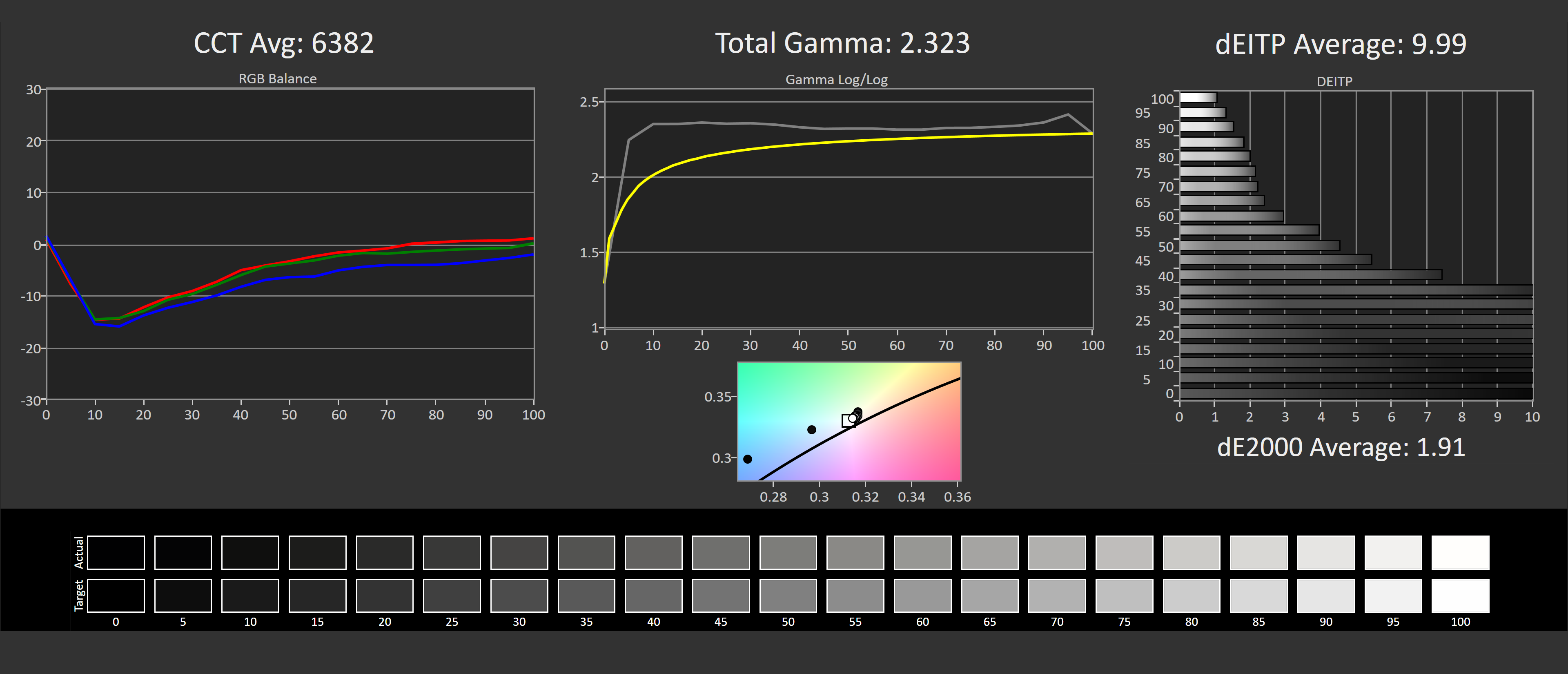
Not bad, but not amazing. A greyscale deltaE 2000 average of 1.91 is respectable and above average for a gaming grade display, and there was no noticeable tint with the retail unit Samsung sent. However the gamma is a bit off, particularly on the low end. What you see below 30% grey is too high of a gamma by default, and what this means is dark shades can be darker than they should be. For gamers this might make dark environments harder to spot enemies in, and for accuracy purists well, it's not quite accurate.
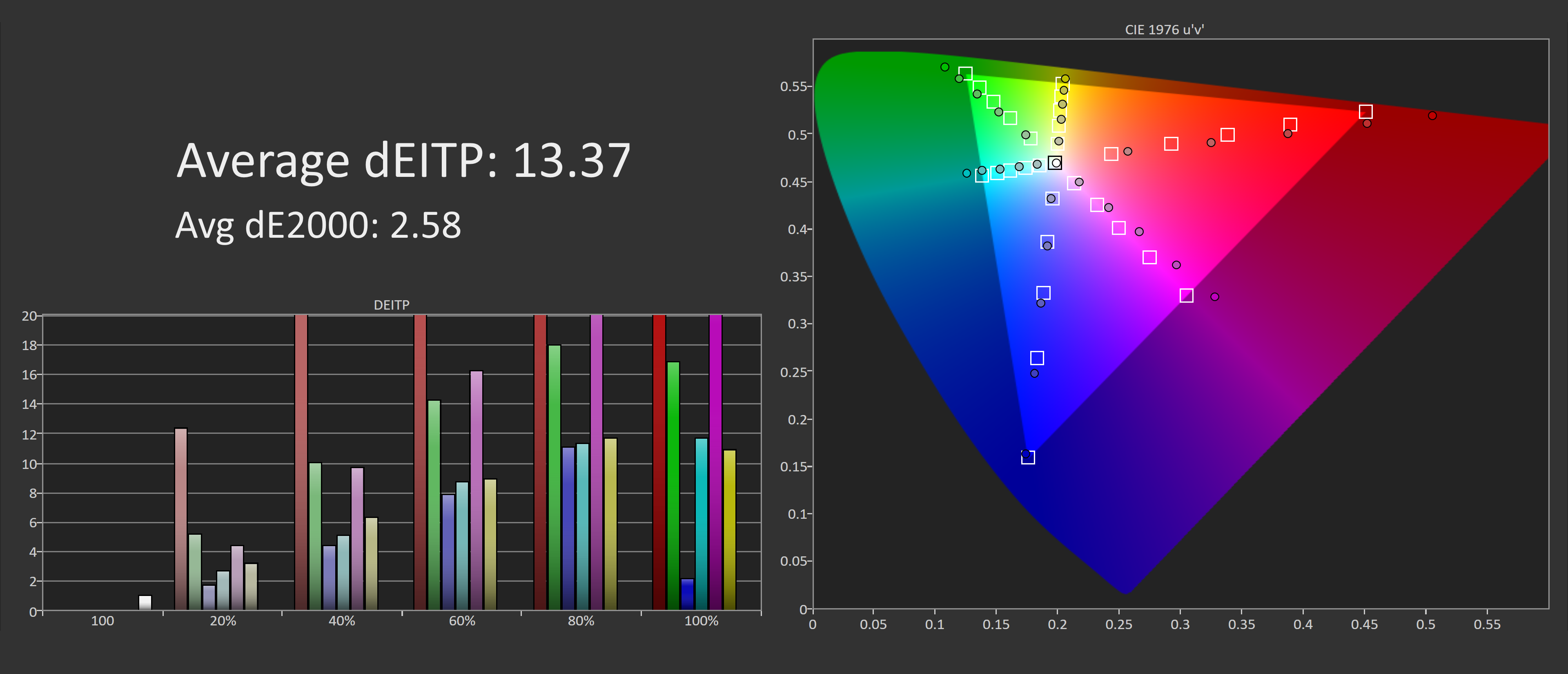
Saturation performance is okay but the monitor does suffer from not having any sRGB clamp by default, the age old issue we see with wide gamut displays. This means that without any further tweaking, the Odyssey G7 will oversaturate standard sRGB images. Similar situation with ColorChecker, a deltaE average of 16.46 is not great.

How did Samsung get a sub 2.0 deltaE average for this monitor at the factory? It's not specified, but we believe they would have tested against P3, where I saw a default ColorChecker deltaE 2000 average of 1.95. Not too far off the 1.89 listed in the OSD.
OSD Tweaked Color Performance
As for OSD tweaks to improve color performance, in our opinion there are some strange choices made by default. For example, we believe the default sharpness setting of 60 is slightly oversharpening the display, effectively post processing the image. Dropping that down to 56 removed some light haloing. Dynamic brightness is also enabled by default, although for the tests you just saw that was disabled as it messes with the results.
The strangest one was the Black Equalizer set to 13 by default. We believe this setting is the cause of that too-high gamma we saw earlier for dark shades. It does make the display 'pop' as darks are darker, but it's not accurate, turning that back to 10 or 9 delivers the best results in terms of proper gamma performance.
On top of this, the Odyssey G7 includes an sRGB mode but it's functionally useless as it doesn't clamp the display to an sRGB gamut. That's disappointing when other high end wide gamut monitors do have proper sRGB modes.

Back to OSD tweaked performance, you can see that especially by changing that Black Equalizer setting, we get much better gamma performance and superior deltaEs, if you think the monitor is too dark out of the box, this might be the setting to change. Outside of greyscale these settings only have a minor impact to performance.
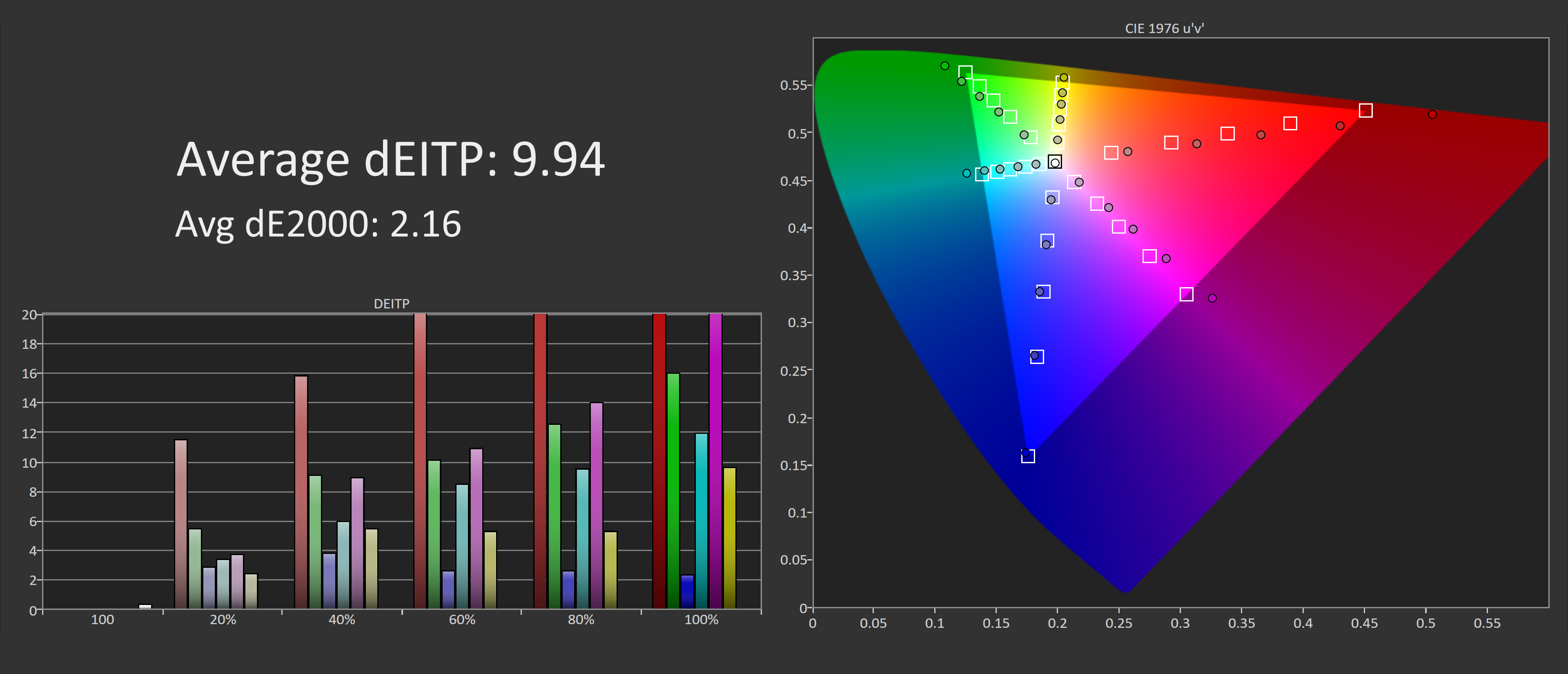

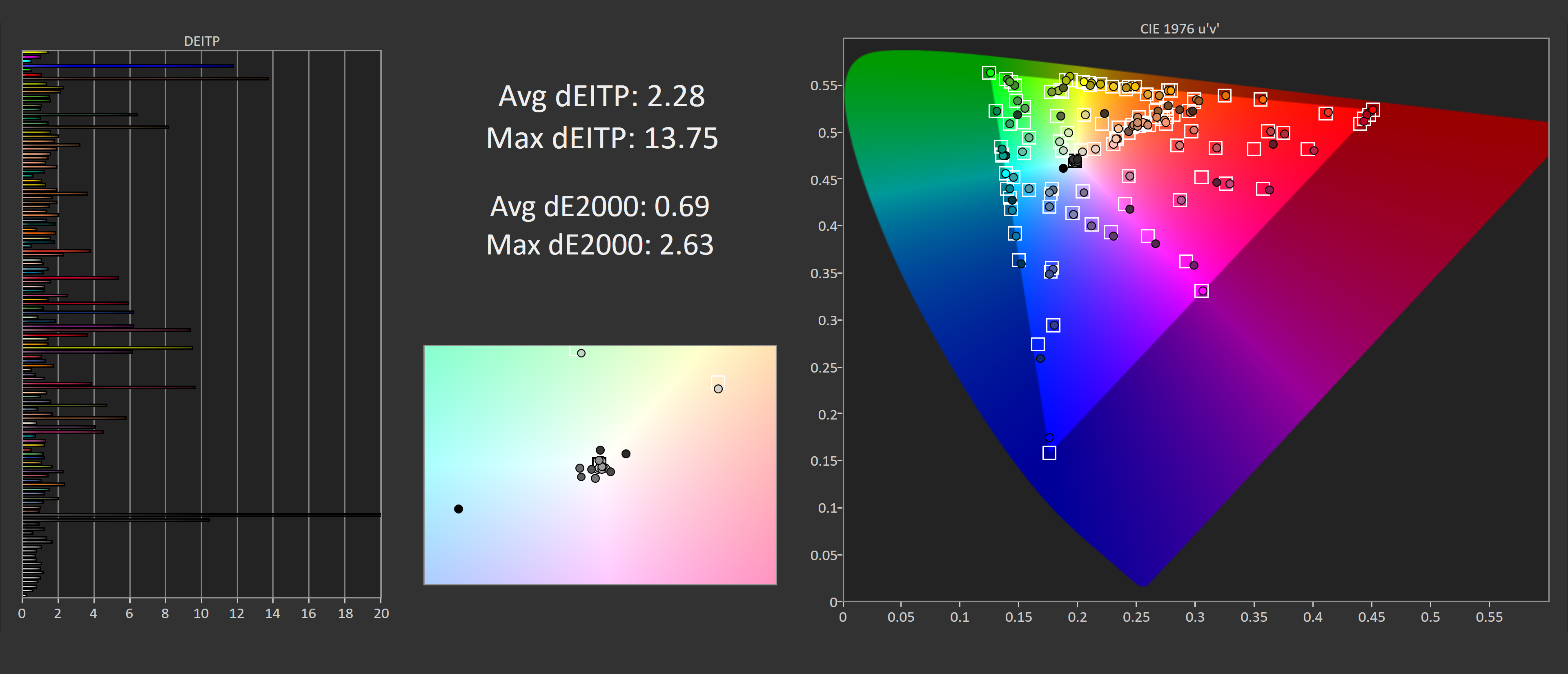
Calibrated Color Performance
Finally, our full calibration results after a pass through DisplayCAL. Excellent sRGB performance thanks to easy 100% coverage, and a nice adherence to the sRGB gamma curve. We end up with deltaE ITPs around 2.0 and deltaE 2000s below 1.0 which is an excellent result.

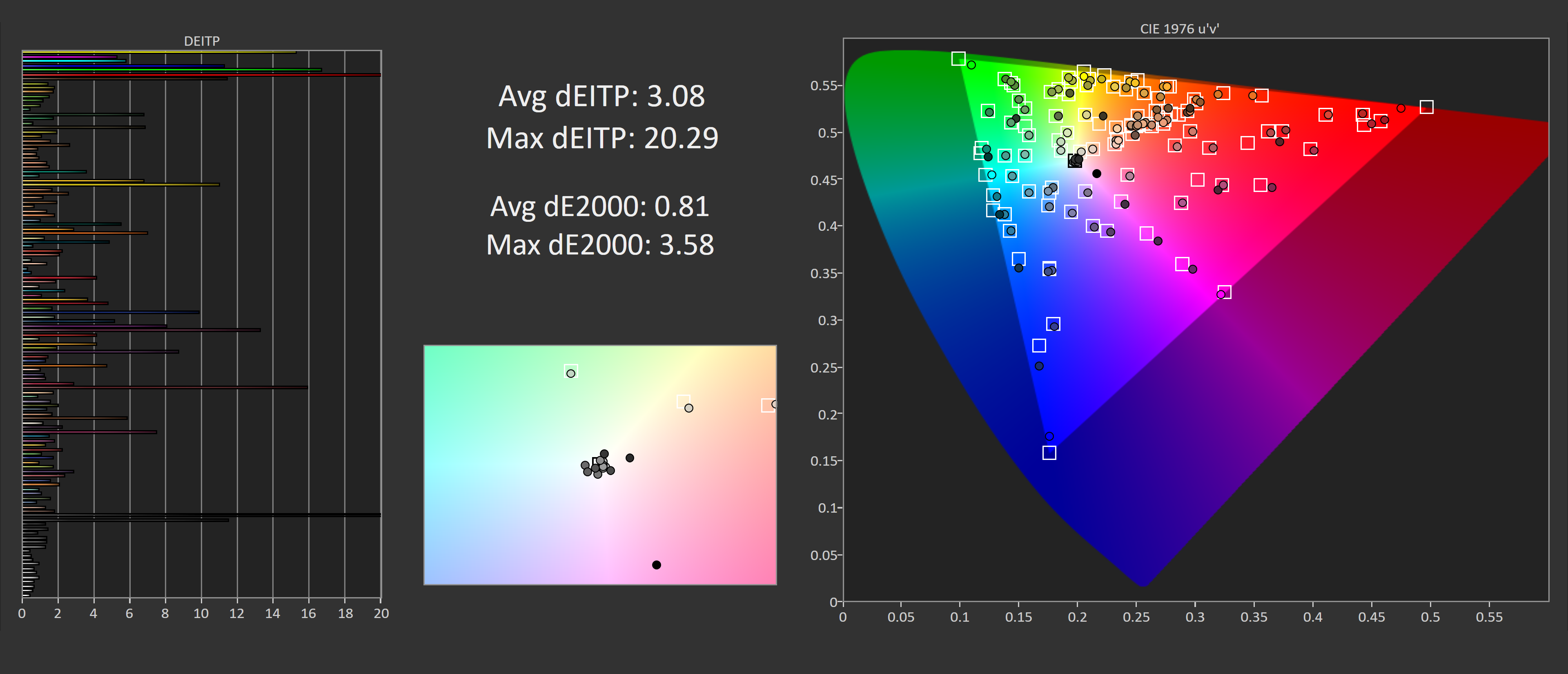
Calibrated P3 performance is also strong with the exception of top-end colors as the display delivers just 89% coverage of the P3 color space. If you really need an accurate monitor for P3 work, we'd recommend choosing an IPS instead.

Brightness, at least in the SDR mode, is decent at around 360 nits after calibration. Although you can't just get the display to run at 600 nits all the time despite supporting that for DisplayHDR 600 reasons. Minimum brightness of 71 nits is on the higher end though.

The native contrast ratio of this panel is disappointing in our opinion, at just 2000:1. This is on the lower end for a VA display, the better ones can exceed a 3000:1 ratio. This is much higher than say, a 27GL850 - we're looking at a contrast ratio 3x as high - but relative to some of the better IPS offerings, black levels are less than twice as good.
Viewing angles are fine, similar to other VA panels but of course due to the aggressive 1000R curve this isn't a monitor you'll want to view at any angle other than dead straight on.
The most disappointing aspect to color performance is uniformity. Not necessarily full white uniformity, which is fine, but more darker shade uniformity like we saw from this 30% grey reading. The edges of this display are particularly inaccurate and that's caused by noticeable backlight bleed, which presents for greys like this as a brighter vignette around the edges.
The backlight bleed is arguably worse for blacks, where we could notice the bleed under reasonably bright lighting which is not good. And in a dark room, the bottom edge of this monitor almost has an IPS glow-like appearance. VAs tend to be decent in this regard, so the Odyssey G7 is a significant outlier and we suspect most people who end up with a unit like mine will be able to notice this bleed.

As for HDR performance, we plan to go in-depth on HDR testing later on, but for this review we'll stick to the checklist, which reveals semi-HDR performance. We do get a peak brightness of 600 nits and around 90% coverage of P3 so we do get two of the three pillars of HDR. As the native contrast for the panel is low at around 2000:1, to get the proper contrast required for HDR content, we need local dimming.
Samsung has used an entry-level local dimming implementation with just 8 edge lit zones. This can help deliver a higher contrast ratio in some situations, but its usefulness is limited, hence why we label these monitors as "semi-HDR". The experience you get here is far from the best HDR monitors with FALD backlights, it's a little bit better than SDR, but it's not a key selling point in our opinion.
What's to Like?
The Samsung Odyssey G7 does some stuff really well. Better than almost any other monitor on the market, but it's certainly not perfect. Samsung absolutely nailed the Odyssey G7's response time performance. This display delivers elite response times, almost equivalent to a modern TN panel and exceeding the fastest IPS displays we've tested.
When paired with a top end 240Hz refresh rate, we get a remarkably clear image, free of ghosting and smearing. Even dark level performance is decent, a notorious downside of VA panels that has turned away prospective buyers for years. On top of that, this performance is seen across the entire refresh range with no need for overdrive adjustments, all without significant overshoot.
Given this TN-like response time, experience is paired with double the contrast ratio, better viewing angles, a wide gamut experience and a bit of semi-HDR on top. We'd say that overall the G7 is a better choice than a TN equivalent like the HP Omen X 27, even if the Omen is slightly faster and also cheaper.
Other good stuff includes the monitor's build quality, stand, brightness and even some aspects to factory calibration. We're not sold on the HDR functionality, but at least the experience is somewhat better than a regular SDR displays that get HDR 400 slapped on the box.
Now, put in proper context, this is still a high-end gaming monitor with a $700 asking price for the 27-inch version and $800 for the 32-inch model we've tested. At that price point, the Odyssey G7 is at least $200 more expensive than our previous 27" 1440p recommendation, the excellent LG 27GL850, while the 32-inch is basically the most expensive 1440p monitor on the market overall.
Samsung has delivered amazing response times but in other areas you're not getting the same treatment. For example, our review unit had too much backlight bleed and poor grey uniformity, which noticeably hurts image quality and is a regression compared to other VAs. The contrast ratio is also average for a VA, especially when displays with well over 3000:1 ratios are now available.
Samsung also made some strange choices with their factory calibration options, including post-processing the display, darkening blacks and including a sRGB mode that doesn't clamp to sRGB. At $800, we're not expecting professional-grade calibration, but we think it's fair to expect at least a proper sRGB mode. We'd also expect HDMI 2.1 for future proofing and a better backlight strobing mode.
Then is the curve. In our opinion, this is a step in the wrong direction. While we always prefer flat panels, there would have been no complaints had they stuck to an 1800R curve. 1000R is going too far, although Samsung is promoting this as a feature.
If this monitor was flat, we could be looking at a highly versatile monitor, with wide appeal for gamers and the ability to double as a solid creator monitor with a better-than-IPS contrast ratio, limited dark level smearing, and 90% P3 coverage. That dual use potential would significantly increase the value proposition of the Odyssey.
The 1000R curve and the distortion it introduces shuts off the Odyssey G7 from the productivity/creator market and shuts itself off from the portion of gamers that dislike curved monitors. The 1000R curve could be game-changing on the super ultrawide Odyssey G9, but on the regular 16:9 G7, it's a bit of a miss.
That's not to say the Odyssey G7 is a bad monitor. If response times are your only concern - you want the fastest experience out there and not TN-level bad colors - then the Odyssey G7 is absolutely the monitor you should choose. But flagship products with premium price tags lead to high expectations, and when considering the overall package we don't think the performance is quite there for a $700 or $800 product.
Moreover, competition is about to get really hot in the coming months. LG is set to introduce the 27GN950 at $700, which is a 4K 144Hz IPS monitor with DisplayHDR 600. We're also expecting the first 1440p 240Hz IPS displays to slot in around the $600 mark. Of course, we haven't tested those displays yet, but people interested in a high-end monitor might benefit from waiting. We might get that more versatile, or better performing option.
Bottom line, Samsung has done fantastic things with this next generation VA panel technology, even if the Odyssey G7 doesn't hit all the right marks. VA is absolutely back as a contender for high-end gaming displays and we're excited to see where this goes.
